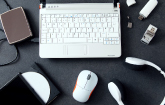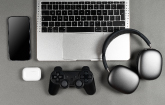
DELRAY BEACH, Fla., Sept. 8, 2025 /PRNewswire/ -- The global Wearable Healthcare Devices Market, valued at US$41.07 billion in 2024, stood at US$45.29 billion in 2025 and is projected to advance at a resilient CAGR of 10.9% from 2025 to 2030, culminating in a forecasted valuation of US$75.98 billion by the end of the period. Market growth is driven by rising health awareness, a shift toward preventive care, and the increasing prevalence of chronic conditions in aging populations. Advancements in wearable technologies—including AI-enabled analytics, real-time monitoring, and integration with electronic health records—have expanded the scope of these devices from fitness tracking to clinical-grade diagnostics and therapeutic support. Additionally, growing public and private investments, widespread smartphone penetration, improved connectivity, and the preference for wireless monitoring in home and clinical settings are contributing to market expansion. The adoption of AI and the rollout of 5G are expected to further accelerate innovation in this space. However, challenges such as the lack of regulatory standardization, concerns regarding data security, and limitations in clinical accuracy may restrain growth to some extent.
Download PDF Brochure: https://www.marketsandmarkets.com/pdfdownloadNew.asp?id=81753973
Browse in-depth TOC on "Wearable Healthcare Devices Market"
430 - Tables
50 - Figures
352 - Pages
By product, the wearable healthcare devices market is segmented into trackers, smartwatches, patches, and smart clothing. In 2024, smartwatches emerged as the fastest-growing product segment, driven by their expanding range of health-focused features, seamless integration with digital ecosystems, and increasing user demand for multifunctional and accessible health monitoring solutions. These devices are widely used to track vital health parameters such as heart rate, blood oxygen levels, and sleep patterns, while also supporting fitness and wellness goals. Ongoing innovations in sensor technologies, AI-enabled health insights, and real-time data analytics have significantly enhanced the appeal of smartwatches for both consumers and healthcare professionals. The rising global adoption of smartphones improved mobile connectivity, and a growing emphasis on preventive healthcare are further accelerating their growth. While trackers and patches continue to find relevance in targeted applications like fitness tracking and chronic disease monitoring, and smart clothing gains traction in niche areas such as sports and rehabilitation, smartwatches remain the most dynamic and rapidly advancing segment in the wearable healthcare landscape due to their versatility, convenience, and strong consumer engagement.
By grade, the wearable healthcare devices market is segmented into consumer-grade and clinical-grade devices. In 2024, consumer-grade wearable healthcare devices captured the largest market share, primarily due to the widespread adoption of smartphones, advancements in sensor miniaturization, and their seamless integration with mobile health applications. These devices—such as smartwatches, fitness trackers, wristbands, and smart clothing—are easily accessible to the general public without the need for a prescription and are widely used in fitness, wellness, and lifestyle management. While they often include features like heart rate monitoring, ECG, and sleep tracking, consumer-grade devices are primarily intended for general wellness and do not meet the stringent clinical accuracy or regulatory standards required for medical diagnosis or treatment. Some devices, like the Apple Watch, have obtained regulatory approvals for specific features, but their primary market positioning remains consumer focused. Their ability to monitor a broad range of physiological parameters, combined with user-friendly features like Bluetooth connectivity, GPS, and smartphone sync, has made them especially popular among tech-savvy users and aging populations seeking convenient, non-invasive health tools.
By geography, the wearable healthcare devices market is segmented into North America, Europe, Asia Pacific, Latin America, the Middle East & Africa, and the GCC countries. In 2024, North America held the largest share of the global market, driven by its advanced healthcare infrastructure, high smartphone penetration, and strong emphasis on digital health adoption. The region benefits from rising consumer awareness, growing demand for remote patient monitoring, and increasing incidence of chronic conditions such as diabetes, obesity, and cardiovascular diseases. According to Pew Research (2024), a significant portion of Americans own smartphones and actively use wearable health-tracking devices, creating a favorable environment for market expansion. The continued rise in healthcare costs—CMS reported a 7% increase in national health spending in 2023 to USD 4.8 trillion (17.6% of GDP)—has further propelled the shift toward cost-effective, home-based care models supported by wearables. Moreover, supportive government initiatives such as Medicare and Medicaid reimbursements for remote patient monitoring have accelerated adoption. The presence of major market players, including Apple Inc. (US), Fitbit Inc. (US), Garmin Ltd. (US), and DexCom, Inc. (US), coupled with a strong regulatory framework and robust connected health ecosystem, is expected to sustain North America's dominance in the wearable healthcare devices market in the coming years.
Request Sample Pages : https://www.marketsandmarkets.com/requestsampleNew.asp?id=81753973
Prominent players in the wearable healthcare devices market are Apple Inc. (US), Samsung (South Korea), Abbott (US), DexCom, Inc. (US), Fitbit Inc. (US), Koninklijke Philips N.V. (Netherlands), OMRON Corporation (Japan), Garmin Ltd. (US), GE HealthCare (US), Masimo (US), Boston Scientific Corporation (US), Biotricity (US), iRhythm Technologies, Inc. (US), and CONTEC MEDICAL SYSTEMS CO., LTD. (China).
Apple Inc. (US):
Apple Inc. is a leading player in the global wearable healthcare devices market, with a strong presence across North America, Europe, Latin America, and the Middle East & Africa. The company consistently strengthens its competitive edge by expanding its product portfolio and making strategic investments in innovation. Apple has significantly increased its R&D spending over the years—investing USD 26.25 billion in 2022, USD 29.92 billion in 2023, and USD 31.37 billion in 2024—underscoring its commitment to developing cutting-edge technologies and diversifying into emerging markets. Apple primarily adopts organic growth strategies to sustain its leadership in the wearable healthcare space. In July 2025, the company launched the Apple Watch Series 10, its thinnest and most advanced model to date. The device features the largest display in the Apple Watch lineup, new sleep apnea detection capabilities, water depth and temperature sensing, faster charging, and AI-powered health and fitness insights integrated with watchOS 11. These innovations further solidify Apple's positioning as a front-runner in personal health monitoring and reinforce its commitment to delivering comprehensive wellness solutions through wearable technology.
Samsung (South Korea)
Samsung is a global technology leader engaged in the design and manufacturing of consumer electronics, semiconductors, and communication devices. The company operates through four main business segments: DX (Device eXperience), DS (Device Solutions), SDC (Samsung Display), and Harman. Wearable devices, including smartwatches and fitness trackers, are offered under the DX division. Samsung is a prominent player in the wearable healthcare devices market, particularly in the smartwatch and fitness tracker segments. The company's competitive advantage stems from its strong brand presence, broad global customer base, and advanced sensor integration capabilities. Its Galaxy Watch series has been effectively positioned as a multifunctional health monitoring tool, featuring clinical-grade capabilities such as sleep apnea detection, heart rate monitoring, and electrocardiogram (ECG) functionality. These features have reinforced Samsung's status as a key innovator in the consumer healthcare wearables space.
Abbott (US)
Abbott is a global healthcare company engaged in the discovery, development, and manufacturing of a broad range of healthcare solutions. The company operates through four primary business segments: Pharmaceuticals, Diagnostics, Nutrition, and Medical Devices. Its wearable healthcare offerings are primarily delivered through the Medical Devices segment, particularly within the Diabetes Care division, which provides continuous glucose monitoring (CGM) systems, test strips, sensors, data management tools, and related accessories for diabetes management. Abbott's strong international presence and the essential role of its products have positioned it as a key player in improving healthcare access across both developed and emerging markets. The company places a strong focus on research and development to drive innovation and maintain its competitive advantage. In 2024, Abbott invested USD 2.84 billion in R&D, underscoring its commitment to delivering advanced, high-quality wearable healthcare solutions.
For more information, Inquire Now!
Related Reports:
Medical Device Connectivity Market
Top 10 Medical Device Technologies Market
Get access to the latest updates on Wearable Healthcare Devices Companies and Wearable Healthcare Devices Market Size
About MarketsandMarkets™:
MarketsandMarkets™ has been recognized as one of America's Best Management Consulting Firms by Forbes, as per their recent report.
MarketsandMarkets™ is a blue ocean alternative in growth consulting and program management, leveraging a man-machine offering to drive supernormal growth for progressive organizations in the B2B space. With the widest lens on emerging technologies, we are proficient in co-creating supernormal growth for clients across the globe.
Today, 80% of Fortune 2000 companies rely on MarketsandMarkets, and 90 of the top 100 companies in each sector trust us to accelerate their revenue growth. With a global clientele of over 13,000 organizations, we help businesses thrive in a disruptive ecosystem.
The B2B economy is witnessing the emergence of $25 trillion in new revenue streams that are replacing existing ones within this decade. We work with clients on growth programs, helping them monetize this $25 trillion opportunity through our service lines – TAM Expansion, Go-to-Market (GTM) Strategy to Execution, Market Share Gain, Account Enablement, and Thought Leadership Marketing.
Built on the 'GIVE Growth' principle, we collaborate with several Forbes Global 2000 B2B companies to keep them future-ready. Our insights and strategies are powered by industry experts, cutting-edge AI, and our Market Intelligence Cloud, KnowledgeStore™, which integrates research and provides ecosystem-wide visibility into revenue shifts.
To find out more, visit www.MarketsandMarkets™.com or follow us on Twitter, LinkedIn and Facebook.
Contact:
Mr. Rohan Salgarkar
MarketsandMarkets™ INC.
1615 South Congress Ave.
Suite 103, Delray Beach, FL 33445
USA: +1-888-600-6441
Email: [email protected]
Visit Our Website: https://www.marketsandmarkets.com/
Logo: https://mma.prnewswire.com/media/1868219/MarketsandMarkets_Logo.jpg
SOURCE MarketsandMarkets







Share this article